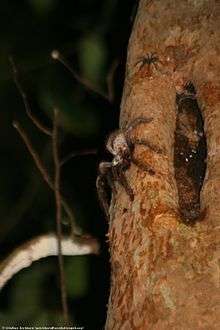Cyriopagopus
| Cyriopagopus | |
|---|---|
 | |
| Cyriopagopus schioedtei in Borneo, Malaysia | |
| Scientific classification | |
| Kingdom: | Animalia |
| Phylum: | Arthropoda |
| Subphylum: | Chelicerata |
| Class: | Arachnida |
| Order: | Araneae |
| Infraorder: | Mygalomorphae |
| Family: | Theraphosidae |
| Genus: | Cyriopagopus Simon, 1887[1] |
| Synonyms[1] | |
| |
Cyriopagopus is a genus of spiders in the family Theraphosidae (tarantulas) found in Southeast Asia, from Myanmar to the Philippines. As of March 2017, the genus includes species formerly placed in Haplopelma.[1]
Description
The species formerly placed in Haplopelma are medium to large spiders; for example, Cyriopagopus schmidti females have a total body length, including chelicerae, up to 85 mm (3.3 in), with the longest leg, the first, being about 70 mm (2.8 in) long. The carapace (upper surface of the cephalothorax) is generally dark brown. They have eight eyes grouped on a distinctly raised portion of the cephalothorax, forming a "tubercle". The forward-facing (prolateral) sides of the maxillae have "thorns" which act as a stridulating organ. The first leg is usually the longest, followed by the fourth, second, and third. Mature females have an M-shaped spermatheca. Mature males have a spur on the forward-facing sides of the tibiae of the first pair of legs and a pear-shaped palpal bulb with a wide, curved embolus.[2]
Taxonomy
The nomenclature of a group of theraphosid genera from South and Southeast Asia, including Cyriopagopus, Haplopelma, Lampropelma, Omothymus, and Phormingochilus, is somewhat confused. The status of the genera has changed several times recently, and species have been moved from one genus to another. Currently, Haplopelma is considered to be a junior synonym of Cyriopagopus, and Melopoeus of Haplopelma, hence of Cyriopagopus, but this may change.[1][3]
The genus Cyriopagopus was erected by Eugène Simon in 1887 for the species Cyriopagopus paganus from Burma. In 1985, Robert Raven made Cyriopagopus the senior synonym of Melognathus Chamberlin, 1917. In 1890, Tamerlan Thorell described a species of spider under the name Selenocosmia doriae. In 1892, Eugène Simon decided that this species was sufficiently different from others placed in the genus Selenocosmia to warrant a new genus, Haplopelma, with one species, Haplopelma doriae.[1][4] Raven in 1985 also decided that Haplopelma was the senior synonym of Melopoeus Pocock, 1895. A. M. Smith studied the type specimen of Cyriopagopus paganus (the type species of Cyriopagopus) and decided that it had the key characteristics of Haplopelma, making Cyriopagopus the senior synonym of Haplopelma.[3] This analysis is accepted by the World Spider Catalog as of March 2017, with the comment that "Haplopelma, Cyriopagopus, Melopoeus, and other ornithoctonine genera are in urgent need of revision".[1]
Species
As of March 2017, the World Spider Catalog accepted these species:[1]
- Cyriopagopus albostriatus (Simon, 1886) – Myanmar, Thailand, Cambodia
- Cyriopagopus doriae (Thorell, 1890) – Borneo
- Cyriopagopus dromeus (Chamberlin, 1917) – Philippines
- Cyriopagopus hainanus (Liang, Peng, Huang & Chen, 1999) – China
- Cyriopagopus lividus (Smith, 1996) – Myanmar
- Cyriopagopus longipes (von Wirth & Striffler, 2005) – Thailand, Cambodia
- Cyriopagopus minax (Thorell, 1897) – Myanmar, Thailand
- Cyriopagopus paganus Simon, 1887 (type species) – Myanmar
- Cyriopagopus robustus (Strand, 1907) – Singapore
- Cyriopagopus salangense (Strand, 1907) – Malaysia
- Cyriopagopus schmidti (von Wirth, 1991) – China, Vietnam
- Cyriopagopus vonwirthi (Schmidt, 2005) – Southeast Asia
- Transferred to other genera
- Cyriopagopus schioedtei (Thorell, 1891) → Omothymus schioedtei
- Cyriopagopus thorelli (Simon, 1901) → Omothymus thorelli
Distribution and habitat
The genus is found in Southeast Asia (China, Myanmar, Thailand, Cambodia, Vietnam, Malaysia, and Singapore), Borneo, and the Philippines. Species that have been studied live in underground, silk-lined tubes, often with a surrounding web of radiating signal threads. They may be found in small colonies at the base of trees or bamboos. Some species favour steep, south-facing slopes.[2]
Toxicity
Like all Old World tarantulas, spiders in the genus Cyriopagopus lack the urticating hairs found in their New World counterparts,[5] hence use biting as a primary means of both attack and defence. Some Cyriopagopus species are among those reported to have more toxic venom. Although bites may cause severe pain and a range of other effects, no fatalities are known. Cyriopagopus lividus, C. hainanus, and C. schmidti (under its synonym Selenocosmia huwena) have had their venom characterized. The last two produce hainantoxins and huwentoxins, respectively.[6]
References
- 1 2 3 4 5 6 7 "Gen. Cyriopagopus Simon, 1887", World Spider Catalog, Natural History Museum Bern, retrieved 2017-03-18
- 1 2 Zhu, M.S. & Zhang, R. (2008), "Revision of the theraphosid spiders from China (Araneae: Mygalomorphae)", Journal of Arachnology, 36: 425–447, doi:10.1636/ca07-94.1
- 1 2 Smith, A.M. & Jacobi, M.A. (2015), "Revision of the genus Phormingochilus with the description of three new species from Sulawesi and Sarawak and notes on the placement of the genera Cyriopagopus, Lampropelma and Omothymus", British Tarantula Society Journal, 30 (3): 25–48
- ↑ Simon, E. (1892), "Haplopelma, nov. gen.", Histoire naturelle des araignées, I, Paris: Roret, p. 151, retrieved 2016-05-18
- ↑ Bertani, Rogério & Guadanucci, José Paulo Leite (2013), "Morphology, evolution and usage of urticating setae by tarantulas (Araneae: Theraphosidae)", Zoologia (Curitiba), 30 (4): 403–418, doi:10.1590/S1984-46702013000400006
- ↑ Escoubas, Pierre & Rash, Lachlan (2004), "Tarantulas: eight-legged pharmacists and combinatorial chemists", Toxicon, 43 (5): 555–574, doi:10.1016/j.toxicon.2004.02.007, PMID 15066413